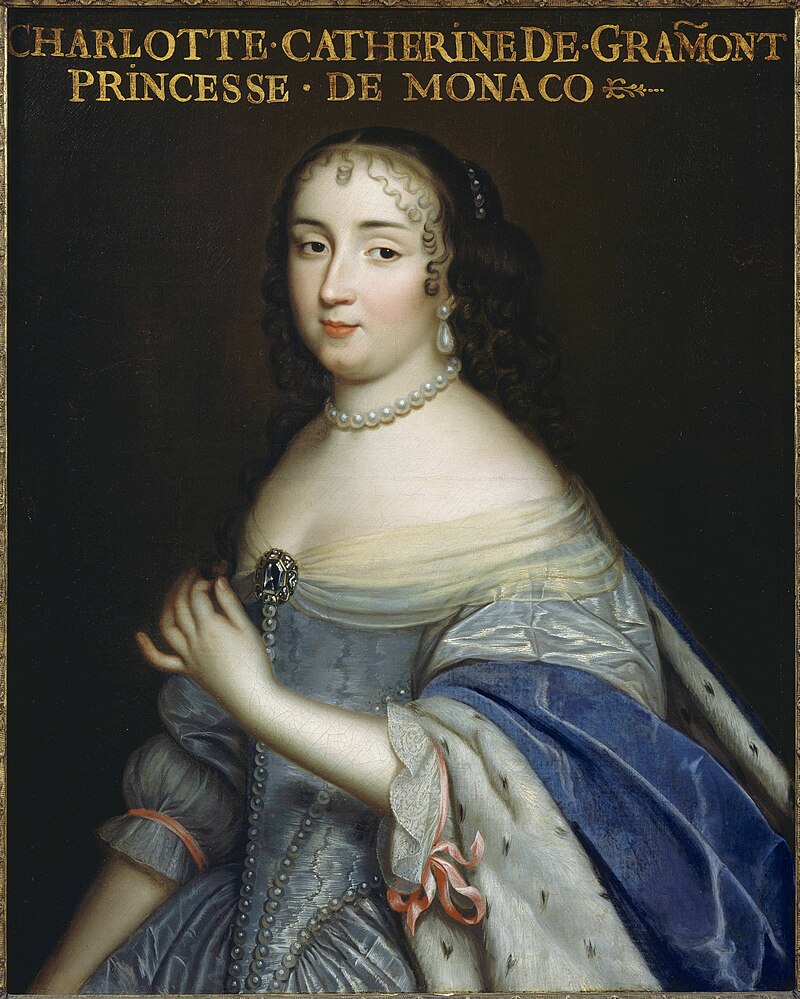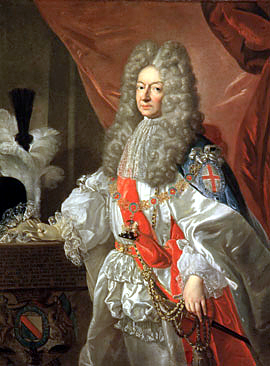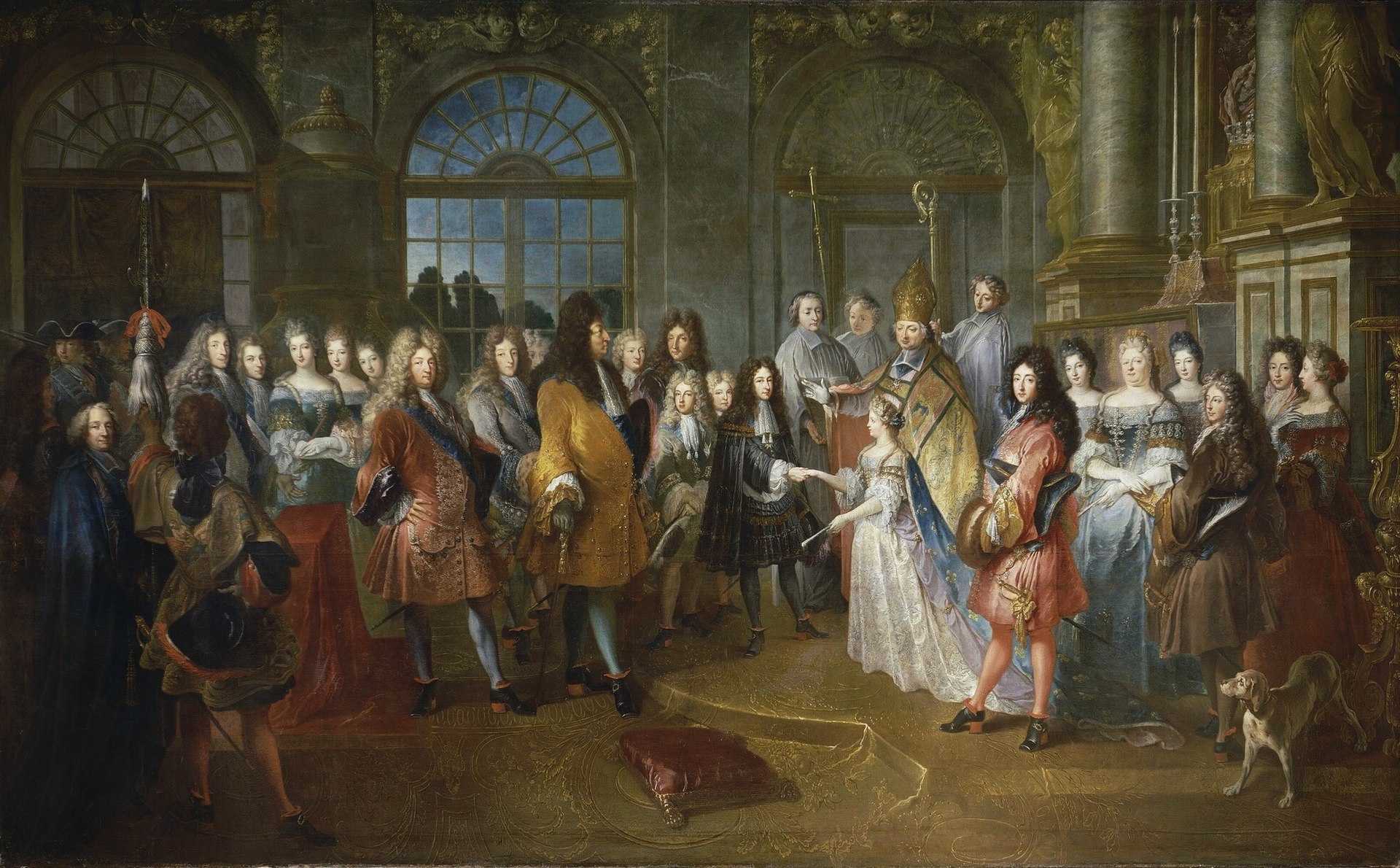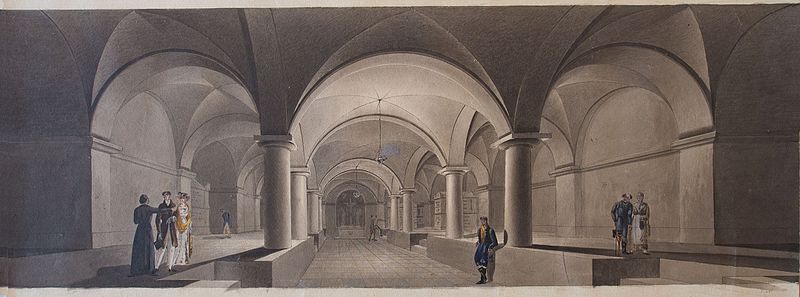by Susan Flantzer
© Unofficial Royalty 2022

Reims Cathedral; Credit – Par Tim Hodson — https://www.flickr.com/photos/informationtakesover/6593926237/, CC BY 2.0, https://commons.wikimedia.org/w/index.php?curid=18031986
Notre-Dame de Reims, also called Reims Cathedral, is a Roman Catholic cathedral in Reims, France dedicated to the Blessed Virgin Mary. It was the coronation cathedral and most Kings of France from 1027 – 1825 were crowned there. Reims Cathedral is the seat of the Archbishop of Reims. The construction of the present Reims Cathedral began in the 13th century and was completed in the 15th century but there were three other cathedrals on the site.

Saint Remigius, Bishop of Reims baptizing Clovis I, King of the Franks; Credit – Wikipedia
The first Christian church in Reims was founded between 250 and 300. In the 5th century, a new church dedicated to the Blessed Virgin Mary was built on the site. About 496, Saint Remigius, Bishop of Reims baptized Clovis I, the first King of the Franks to be baptized. Although there had been some Christians in the Kingdom of the Franks, Clovis’ baptism led to the conversion of the entire population of the Kingdom of the Franks to Christianity.
In 816, Louis I the Pious, King of the Franks and Holy Roman Emperor was crowned in Reims Cathedral by Pope Stephen IV. The coronation revealed the poor condition and inadequate size of the first cathedral. Beginning in 818, a much larger cathedral was built on the site using stone from the old city ramparts. The interior of the new cathedral was decorated with mosaics, paintings, sculptures, and tapestries. The cathedral was consecrated in 862 and, in 976, it began to be enlarged.

Seal of Reims Cathedral, showing how it appeared in the 12th century; Credit – CC BY-SA 3.0, https://commons.wikimedia.org/w/index.php?curid=32910537
By the 12th century, the second cathedral was considered too small. The existing nave and transept were preserved but the two ends of the cathedral were enlarged. The west front and its adjoining tower were demolished and replaced by two matching flanking towers. The major additions to the third cathedral were in the Gothic style but much of the original Carolingian style of the second cathedral remained.
On May 6, 1210, the third Carolingian/Gothic cathedral was destroyed by fire. Construction on the fourth and current cathedral in the High Gothic style began exactly a year later and was completed in 1275, which was exceptionally quick.
On July 24, 1481, during a renovation of the roof, two workers in charge of the lead for the roof, forgot to turn off a furnace, located in the attic of the cathedral. In a short time, the frame of the cathedral was on fire. The fire destroyed the roof, the central bell tower and its ten bells, and part of the transept. Molten lead from the roof destroyed several stained glass windows. King Charles VIII and then King Louis XII provided funds for the necessary renovations.

Interior of Reims Cathedral after World War I bombing; Credit – Wikipedia
Reims Cathedral was near the front lines of World War I and was hit by more than three hundred artillery shells. A major restoration project began in 1919 and was completed in 1938.
********************
The High Altar
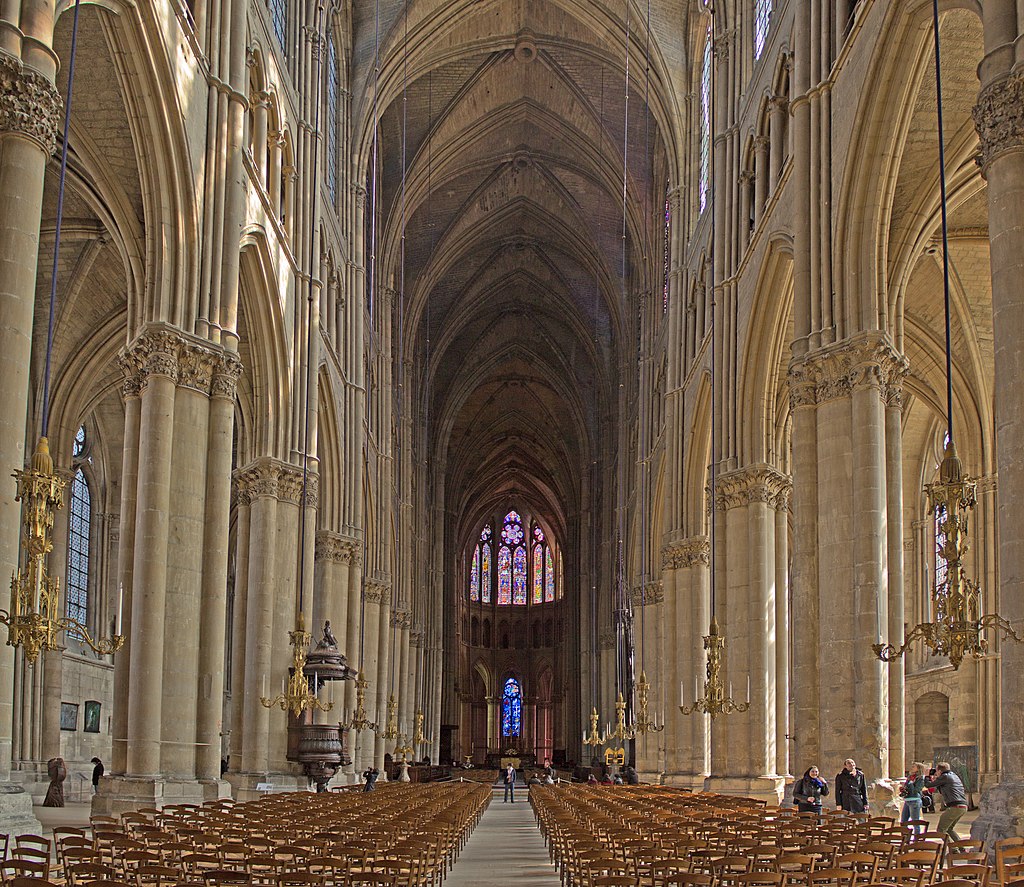
The nave looking east toward the high altar; Credit – By Johan Bakker – Own work, CC BY-SA 3.0, https://commons.wikimedia.org/w/index.php?curid=28038332
The high altar, made of French and Italian marble, is a copy of the 1747 altar which was destroyed by bombing during World War I.

The High Altar; Credit – By Zairon – Own work, CC BY-SA 4.0, https://commons.wikimedia.org/w/index.php?curid=65334623
********************
The Gallery of Kings
On the west facade, above the entrance to the cathedral and the central rose window and continuing on the sides of the cathedral is the Gallery of Kings, statues of French monarchs, each fifteen feet/4.5 meters high. The Gallery of Kings was constructed from 1300 – 1350. At the center is Clovis I, the first King of the Franks to be baptized, with his wife Saint Clotilde on the left and Saint Remigius, Bishop of Reims who baptized him, on the right (see photo below). Saint Clotilde was raised as a Christian and played a role in her husband’s conversion to Christianity and the spreading of Christianity throughout western Europe.

Clovis I, King of the Franks in the center with his wife Saint Clotilde on the left and Saint Remigius, Bishop of Reims on the right; Credit – Wikipedia
*******************
Coronation of Charles VII, King of France and the Impact of Joan of Arc

Coronation of King Charles VII of France at Reims Cathedral. Joan of Arc is standing behind him holding her battle standard. This painting is at the Pantheon in Paris, France; Credit – Wikipedia
Perhaps the most historically symbolic coronation of a French king was the coronation of King Charles VII (reigned 1422 – 1461). He inherited the French throne in desperate times. France was fighting England in the Hundred Years’ War, caused by disputed claims to the French throne between the English House of Plantagenet and the French House of Valois. English forces occupied northern France including Paris and Reims. In 1420, King Charles VI of France had disinherited his son and recognized his son-in-law King Henry V of England and his heirs as the legitimate successors to the French crown. Meanwhile, a civil war was occurring in France between the Armagnacs, supporters of the House of Valois, and the Burgundians, supporters of the House of Valois-Burgundy and allies of the English.
Charles VII’s political and military position improved dramatically with the emergence of Joan of Arc as a military and spiritual leader. The teenage Joan of Arc said she had visions of Saint Michael the Archangel, Saint Margaret of Antioch, and Saint Catherine of Alexandria instructing her to support Charles VII in his efforts to purge the English from France.
Joan of Arc led French troops to victories at the Siege of Orléans and the Battle of Patay. With the English troops dispersed, the population of Reims switched their allegiance to King Charles VII and opened the city’s gates. This allowed for the coronation of King Charles VII on July 17, 1429, at Reims Cathedral with Joan of Arc standing nearby holding her battle standard. After the coronation, Joan knelt before Charles VII and joyously called him king for the first time.
On May 23, 1430, Joan of Arc was captured by the Burgundian faction and handed over to the English. She was tried on several charges including heresy by the pro-English Pierre Cauchon, Bishop of Beauvais, declared guilty, and then burned at the stake on May 30, 1431. In 1456, the Catholic Church ordered a second trial. The first trial and its conclusions were declared “null, void, without value or effect” and Joan and her family were fully rehabilitated.
By the time of her second trial in 1456, Joan of Arc had already become a symbol of France and she remains an important symbol of French identity and unity. On May 16, 1920, Pope Benedict XV canonized Joan of Arc as a saint of the Roman Catholic Church. She is remembered at Reims Cathedral with two statues: an equestrian statue outside the cathedral and another statue in the cathedral.
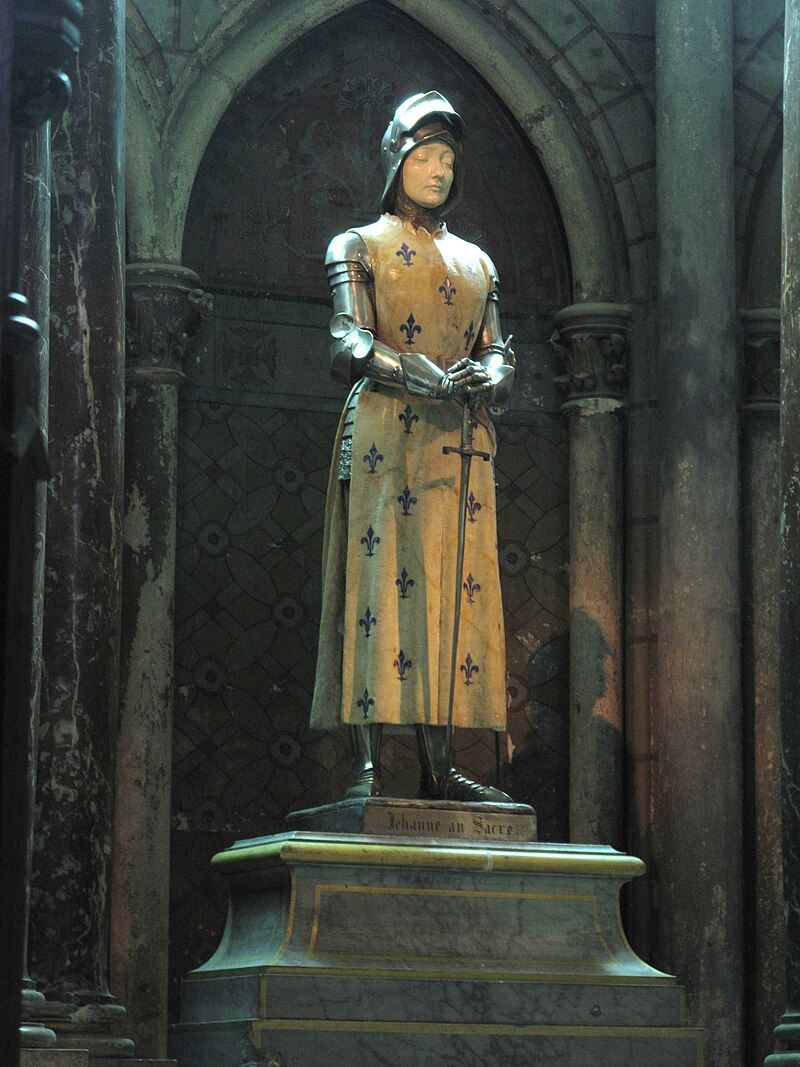
Statue of Joan of Arc in Reims Cathedral; Credit – Wikipedia
French sculptor Prosper d’Epinay created a polychrome statue of Joan of Arc which he exhibited at the Salon des artistes français of 1902, an art exhibition held every year in early February in Paris. Seven years later, one of his patrons offered the statue to Reims Cathedral, at the time of Joan of Arc’s beatification as Blessed Joan of Arc. It stands in the place where Joan of Arc stood during the coronation of King Charles VII. The helmet and the armor were made from silvered bronze, the face was carved in ivory, and the tunic is yellow marble dotted with fleur-de-lis in lapis lazuli.

The original placement of the equestrian statue of Joan of Arc; Credit – Wikipedia
The bronze equestrian statue of Joan of Arc holding a sword in front of Reims Cathedral was designed by French sculptor Paul Dubois and was inaugurated by French President Félix Faure on Bastille Day, July 14, 1896. Originally the statue stood in front of Reims Cathedral with its back toward the cathedral depicting Joan of Arc riding away after Charles VII’s coronation. Today the statue faces the cathedral on the far end of Place du Cardinal-Luçon, the plaza in front of Reims Cathedral, as shown in the photo below.
*******************
Coronations

Coronation of Louis XIII, King of France; Credit – CC BY-SA 4.0, https://commons.wikimedia.org/w/index.php?curid=35561924
The fact that Clovis I had been baptized at Reims Cathedral and the political power of the Archbishop of Reims led to the cathedral becoming the coronation site of Kings of France. After King Henri I was crowned at Reims Cathedral in 1027, the tradition of holding coronations there was firmly established. Since 987, when the House of Capet began its reign, and continuing through the House of Valois and the House of Bourbon, all but seven of France’s kings were crowned at Reims Cathedral. Hugh Capet, Robert II, Louis VI, and Henri IV were crowned elsewhere, Jean I reigned as the posthumous son and successor of Louis X for the five days he lived, and Louis XVIII and Louis Philippe I chose not to have coronations.
In 1804, Napoleon Bonaparte was crowned Napoleon I, Emperor of France at Notre Dame de Paris. With the Bourbon Restoration in 1814 after the downfall of Napoleon I, the practice of royal coronations at Reims Cathedral was resumed, but only once. The Bourbon Restoration saw two brothers of the beheaded King Louis XVI on the French throne. King Louis XVIII decided not to have a coronation. However, in 1825, his younger brother King Charles X was the last King of France to be crowned and his coronation was at Reims Cathedral. King Charles X was overthrown in the Revolution of 1830 and replaced by a constitutional monarch, Louis Philippe, Duke of Orléans I, who reigned as Louis Philippe, King of the French and was sworn in at the Parliament in Paris rather than crowned in Reims.
Louis-Napoléon Bonaparte, a nephew of Napoleon Bonaparte, became President of France after Louis Philippe, King of the French was deposed in the Revolution of 1848. Not content with being simply President, he arranged for a referendum to decide if he should be declared Emperor. On December 2, 1852, following an overwhelming vote in his favor, the Second French Republic ended and the Second French Empire was declared. Louis-Napoleon took the throne as Napoleon III, Emperor of the French. However, Napoleon III chose not to have a coronation ceremony. In 1870, after France’s defeat in the Franco-Prussian War, the Third French Republic was declared, ending, for the last time, the French monarchy.

Coronation of Philippe V and his wife Joan of Burgundy at Reims Cathedral in 1317; Credit – Wikipedia
Several queen consorts were crowned with their husbands at Reims Cathedral. A queen’s coronation could take place years after her marriage or her husband’s accession to the throne. Queen consorts were crowned either together with their husband at Reims Cathedral, alone at Sainte-Chapelle in Paris or the Basilica of Saint-Denis, or not at all.
Coronations at Reims Cathedral

Coronation of King Charles X in 1825 by François Gérard, the last coronation held at Reims Cathedral; Credit – By François Gérard – Web Gallery of Art: Image Info about artwork, Public Domain, https://commons.wikimedia.org/w/index.php?curid=15883911
When Saint Louis IX, King of France was crowned in 1226, the current cathedral was still under construction. The coronation of kings before Louis IX took place at the earlier cathedrals in Reims.
- October 5, 816 – Louis I the Pious, King of the Franks
- January 28, 893 – Charles III the Simple, King of the Franks
- June 30, 922 – Robert I, King of the Franks
- November 12, 954 – Lothair, King of the Franks
- May 14, 1027 – Henri I, King of the Franks
- May 23, 1059 – Philippe I, King of the Franks
- October 25, 1131 – Louis VII, King of France
- November 1, 1179 – Philippe II, King of France
- August 6, 1223 – Louis VIII, King of France, his wife Blanche of Castile was crowned with him
- November 29, 1226 – Saint Louis IX, King of France
- August 30, 1271 – Philippe III, King of France
- January 6, 1286 – Philippe IV, King of France, his wife Joan I, Queen of Navarre was crowned with him
- August 24, 1315 – Louis X, King of France, his second wife Clementia of Hungary was crowned with him
- January 9, 1317 – Philippe V, King of France, his wife Joan II, Countess of Burgundy was crowned with him
- February 21, 1322 – Charles IV, King of France
- May 29, 1328: Philippe VI, King of France
- September 26, 1350: Jean II, King of France, his wife Joan I, Countess of Auvergne and Boulogne was crowned with him
- May 19, 1364: Charles V, King of France, his wife Joan of Bourbon was crowned with him
- November 4, 1380: Charles VI, King of France
- July 17, 1429: Charles VII, King of France
- August 15, 1461: Louis XI, King of France
- May 30, 1484: Charles VIII, King of France
- May 27, 1498: Louis XII, King of France
- January 25, 1515: François I, King of France
- July 25, 1547: Henri II, King of France
- September 21, 1559: François II, King of France
- May 15, 1561: Charles IX, King of France
- February 13, 1575: Henri III, King of France
- October 17, 1610: Louis XIII, King of France
- June 7, 1654: Louis XIV, King of France
- October 25, 1722: Louis XV, King of France
- June 11, 1775: Louis XVI, King of France
- May 29, 1825: Charles X, King of France
This article is the intellectual property of Unofficial Royalty and is NOT TO BE COPIED, EDITED, OR POSTED IN ANY FORM ON ANOTHER WEBSITE under any circumstances. It is permissible to use a link that directs to Unofficial Royalty.
Works Cited
- De.wikipedia.org. 2022. Kathedrale von Reims – Wikipedia. [online] Available at: <https://de.wikipedia.org/wiki/Kathedrale_von_Reims> [Accessed 3 February 2022].
- En.wikipedia.org. 2022. Reims Cathedral – Wikipedia. [online] Available at: <https://en.wikipedia.org/wiki/Reims_Cathedral> [Accessed 3 February 2022].
- Fr.wikipedia.org. 2022. Cathédrale Notre-Dame de Reims — Wikipédia. [online] Available at: <https://fr.wikipedia.org/wiki/Cath%C3%A9drale_Notre-Dame_de_Reims> [Accessed 3 February 2022].
- Fr.wikipedia.org. 2022. Incendie de Notre-Dame de Reims (1481) — Wikipédia. [online] Available at: <https://fr.wikipedia.org/wiki/Incendie_de_Notre-Dame_de_Reims_(1481)> [Accessed 3 February 2022].
- Fr.wikipedia.org. 2022. Sacre des rois de France — Wikipédia. [online] Available at: <https://fr.wikipedia.org/wiki/Sacre_des_rois_de_France> [Accessed 3 February 2022].
- Fr.wikipedia.org. 2022. Statue équestre de Jeanne d’Arc (Paul Dubois) — Wikipédia. [online] Available at: <https://fr.wikipedia.org/wiki/Statue_%C3%A9questre_de_Jeanne_d%27Arc_(Paul_Dubois)> [Accessed 3 February 2022].
- Jenkins, Simon, 2021. Europe’s 100 Best Cathedral. London: Penguin Random House UK.

